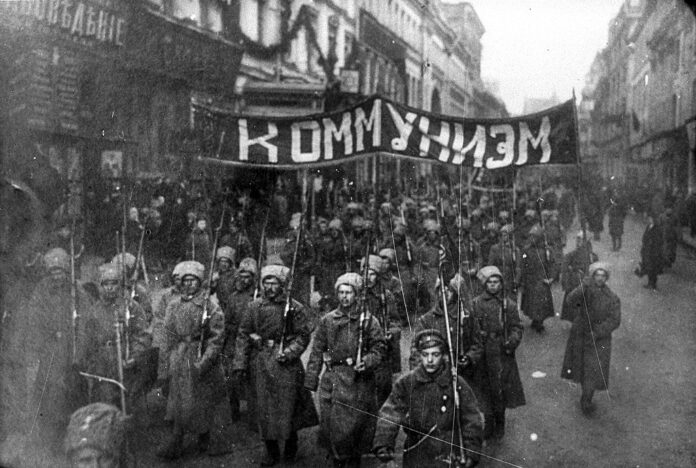On July 26, 1917, the 6th Congress of the Bolsheviks was inaugurated. We present today an article originally published in Greek, written by Panagiotis Vogiatzis.
The 6th Congress of the Bolsheviks commenced on July 26, 1917, in the working-class district of Vyborg in St. Petersburg, amidst conditions of illegality.
20 days prior, the premature uprising of St. Petersburg soldiers and workers ended in defeat, providing the provisional government of bourgeois elements and reformist “socialists” an opportunity to launch a counter-offensive.
The Bolshevik print shop was dismantled and arrest warrants were issued for several of their leaders. Lenin’s warrant was signed by Vishinsky, who later pursued an extensive career as the Procurator General of the Soviet Union during the era of Stalin’s Great Purge. Lenin fled to Finland while Trotsky was imprisoned.
However, the Bolshevik intervention effectively coordinated this setback, rendering it temporary.
In conditions of illegality
In any case, these conditions did not prevent the Bolshevik Party from proceeding with its 6th Congress, clearly underscoring its commitment to open, democratic procedures. Based on this fact alone, Bolsheviks could repel all accusations of authoritarianism, monolithism, etc., which were frequently leveled against their party from various political quarters.
It is noteworthy to mention that despite these extremely harsh circumstances, the Bolsheviks managed to convene two nationwide Conferences (in late March and late April 1917), as well as a Congress and numerous local assemblies. These gatherings occurred during the eight most politically charged months known to humanity and all were characterised by heated debates, open disagreements and -not infrequently- narrow majorities and minorities.
However, these disputes and disagreements never prevented the Bolsheviks from formulating their policies and collectively implementing them. This is the essence of Democratic Centralism after all- not a blind mandate to the leadership.
The democratic legacy of Bolshevism
In this brief note, it is crucial to focus on names and figures -i.e. elements that cannot be easily disputed- in order to contrast the traditions of Bolshevism with the subsequent Stalinist deformation.
As previously noted, both the frequency and the quality of the processes in 1917 were remarkable. This pattern still applied in subsequent years, with party congresses held annually until 1924. Similarly, the Communist International congresses took place in 1919, 1920, 1921, 1922, 1924. We need to note that these events took place during the first years after the October Revolution, a period marked by civil war and foreign invasion.
This trend underwent a dramatic reversal after the Stalinist faction prevailed. The Comintern (Communist International) convened only two more congresses -in 1928 and 1935- over the 19-year span until its official dissolution, which, astonishingly, transpired without a congress in 1943.
Similar trends characterised the internal proceedings of the Communist Party of the Soviet Union (CCSU). A total of only 5 congresses were organised between 1925 and 1952. This was accompanied by a lowering of the political level of congress documents and discussions, as well as the (im-)possibility for any member to disagree with the “line” strictly dictated by a singular figure, Stalin.
The dismantling of the 1917 Central Committee by Stalin
Let’s also highlight certain names- those of the individuals who spearheaded the only victorious proletarian revolution to date.
The 6th Congress elected the new Central Committee (CC) of the Party, comprising 21 full members and 8 deputy members. Shortly after, two more were added through the co-optation method (new members invited by the CC itself), bringing the total to 31 CC members. This stands in stark contrast to the later CCs under Stalin with hundreds of members. These were largely decorative bodies in which most members were only there to perform standing ovations.
However, 8 out of these 31 died or were killed before Stalinism prevailed: Lenin, Dzerzhinsky, Nogin, Artyom, Shahumyan, Sverdlov, Uritsky and Dzhaparidze.
Four died of natural causes in their old age: Stalin, Muranov, Stasova and Kollontai.
Of the remaining 19 (61%), 17 were executed during the Great Purge: Trotsky, Zinoviev, Kamenev, Bukharin, Rykov, Krestinsky, Milyutin, Sokolnikov, Smilga, Preobrazhensky, Kiselyov, Oppokov, Yakovleva, Berzin, Bubnov, Osinsky and Teodorovich; two were driven to suicide (Joffe, Skrypnyk).
Lastly, it is worth noting that among the surviving four (Stalin, Muranov, Kollontai and Stasova), only one played an important role in USSR politics after the 1930s. It was the one who executed his comrades- Stalin.
Hence, to all those claiming that Stalinism naturally evolved from Bolshevism, a simple question arises: if such were the case, why did Stalin find it necessary to unleash a torrent of blood to sever his ties with the original Bolshevik Party leaders, before he was finally able to impose his rule?



